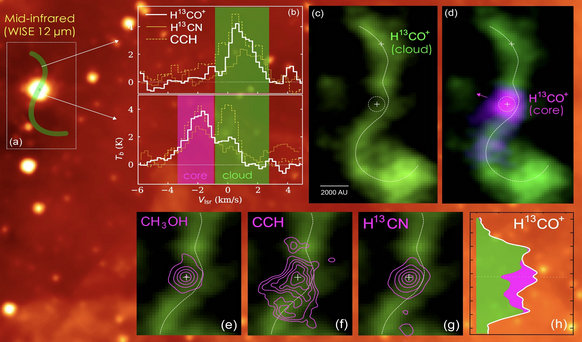
Stars escape from their birth place and eventually become dispersed across the Galaxy. This is an important process in Galactic evolution. Theoretical studies suggest two possible reasons why stars escape. First, stars may be ejected due to interactions in young multiple star systems. Second, they can also obtain kinetic energy during the collapse or interactions of molecular clouds or clumps.
Stars with relatively clear trajectories have usually fully separated from their birth place. In contrast, infant protostars are usually deeply embedded in molecular clouds, making it difficult to measure their kinematical features. As a result, observational data on escaping stars are still very incomplete.
Now, however, a joint team of researchers from the National Astronomical Observatories (NAOC) of the Chinese Academy of Sciences (CAS), the Shanghai Observatory (SHAO) of CAS, and Guangzhou University, using high-resolution molecular spectral lines, has discovered for the first time a protostar leaving its birthplace, thus providing new observational evidence for the initial state of escaping stars.
The study was published in The Astrophysical Journal.
The researchers used the Atacama Large Millimeter/submillimeter Antenna Array (ALMA) to carry out observations towards a large sample of young star-forming regions.
In the star-forming region G352.63-1.07, they found a protostellar core with a noticeable velocity shift. The core was observed in a number of molecular lines, all indicating that the protostar had a different velocity than its parental cloud. At the same time, the molecular lines all closely trace the dense core, thus providing a unique opportunity for measuring the stellar motion.
According to the spectral velocity of the molecular lines, the protostar has a significant blue shift of -2.3 km/s relative to its parental filamentary molecular cloud. At the same time, the core is rightly located at the central dip of the parental cloud, suggesting that the core used to be an internal part of the cloud.
The escape velocity (-2.3 km/s) and the spatial offset (0.025 light year) of the core show that the escape occurred less than 4,000 years ago, with a kinetic energy up to 1045 ergs. This makes the core escape in G352.63-1.07 one of the youngest and most energetic events in the star-forming regions of the Milky Way.
In addition, although the escape velocity of the central star is much lower than that of high-speed ejection stars produced in star clusters, it is actually comparable to the average dispersing velocity of young stars. This suggests that cloud collapse should be the major mechanism for driving escaping stars.
"Stars are giant nuclear fusion reactors in our universe. The escaping star discovered this time is still in its infancy,” said Prof. LI Di, the chief scientist of the Interstellar Medium Group of NAOC and co-author of the article. “This work has snapshotted the initial moment of the stellar escaping motion in nearby active star-forming regions such as Orion Molecular cloud. It enriches the picture of stellar origins and raises a series of challenges.”
In the future, the researchers will conduct more in-depth analyses of multi-star interactions and explosive gas expansion in G352.63-1.07.

(a) Mid-infrared image of G352.63-1.07. (b) Molecular lines at the core center and outside, with the shaded areas indicating the two velocity components. (c) to (g): molecular line image of the two velocity components. (h) H13CO+ line emission slice for the two components along the major extension of the cloud, with the white line denoting their total intensity. (Image by NAOC)

86-10-68597521 (day)
86-10-68597289 (night)

52 Sanlihe Rd., Xicheng District,
Beijing, China (100864)

